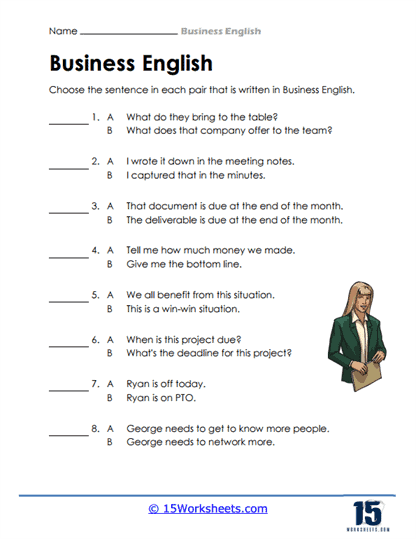
Mastering the Global Marketplace: The Indispensable Role of Business English Worksheets
In today’s hyper-connected, globalized business world, English is undeniably the lingua franca. From multinational corporate boardrooms to international trade negotiations, a strong command of Business English is no longer merely an advantage but a fundamental necessity. It underpins effective communication, fosters collaboration across diverse cultures, and unlocks countless opportunities for professional growth and organizational success. While general English fluency provides a solid foundation, Business English delves deeper, focusing on industry-specific vocabulary, formal communication styles, negotiation tactics, presentation skills, and cross-cultural etiquette.
Acquiring proficiency in Business English requires dedicated and targeted practice. This is where Business English worksheets emerge as an invaluable resource. These structured learning tools offer a focused, practical, and often self-paced approach to mastering the nuances of professional communication. They provide a bridge between theoretical knowledge and practical application, allowing learners to solidify their understanding and build confidence in real-world business scenarios. This article will explore the critical role of Business English, delve into the myriad benefits and types of Business English worksheets, discuss their key elements, and provide guidance on how to effectively integrate them into a comprehensive learning strategy.
The Imperative of Business English in Today’s World

The demand for Business English proficiency stems from several undeniable trends:
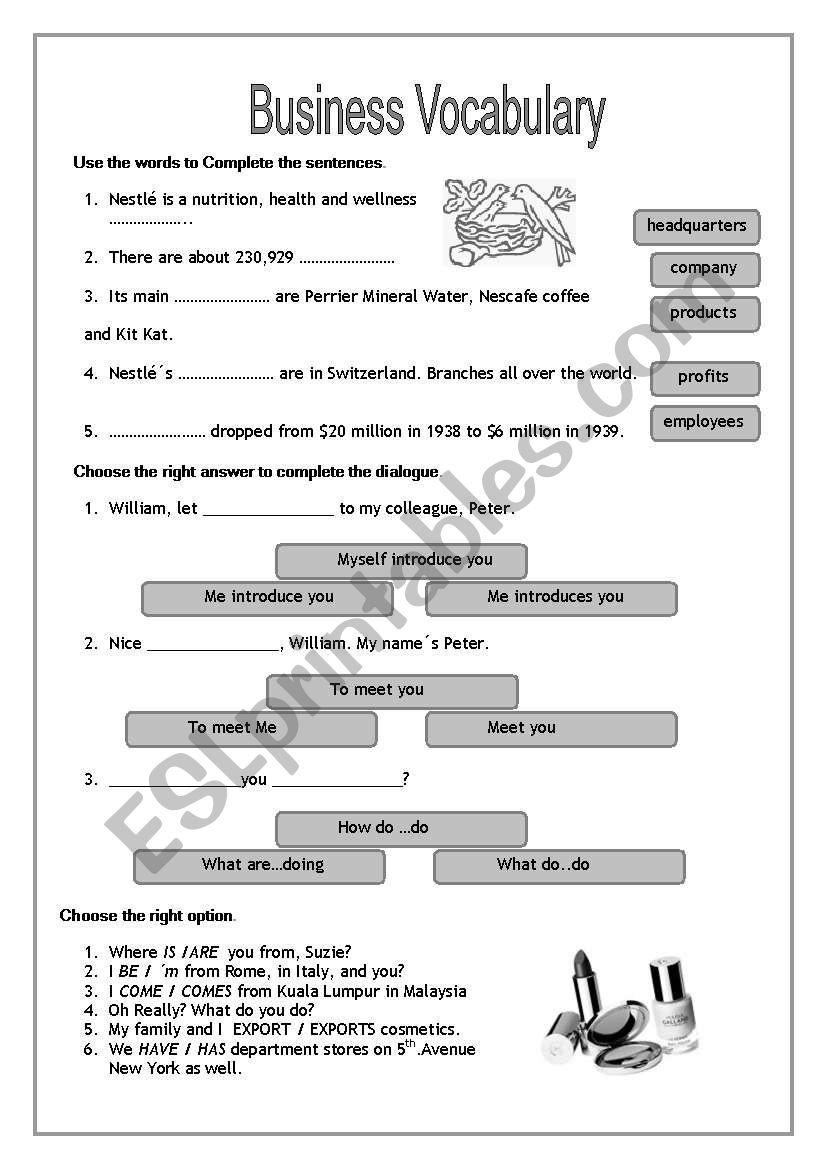
- Globalized Operations: Companies increasingly operate across borders, necessitating seamless communication among employees, partners, and clients from various linguistic backgrounds. English serves as the common denominator.
- Career Advancement: For individuals, a strong command of Business English often correlates with higher earning potential and greater career mobility, opening doors to international assignments, leadership roles, and executive positions.
- Access to Information: A vast majority of global business literature, research, reports, and financial news is published in English. Proficiency allows professionals to stay informed and competitive.
- Effective Collaboration: In diverse teams, clear communication in English minimizes misunderstandings, enhances productivity, and fosters a more inclusive work environment.
- Negotiation and Persuasion: The ability to articulate proposals, negotiate terms, and persuade stakeholders effectively in English is crucial for securing deals and building strong professional relationships.
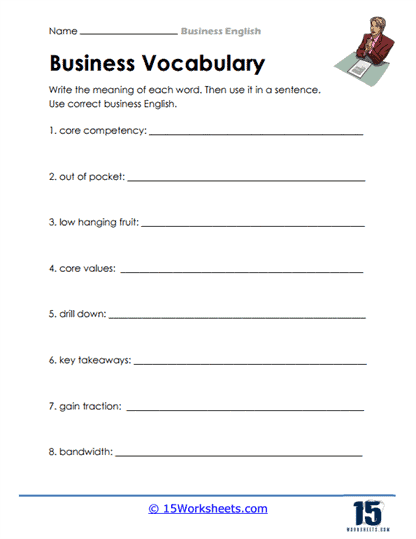
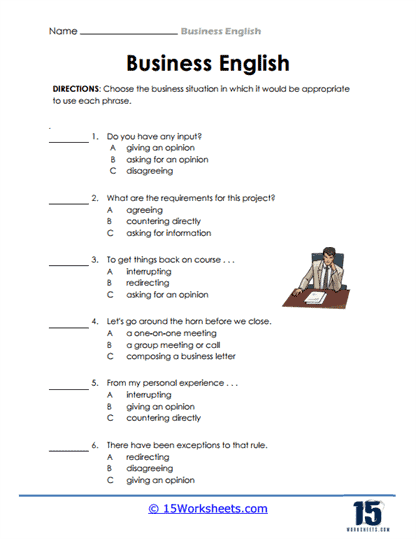
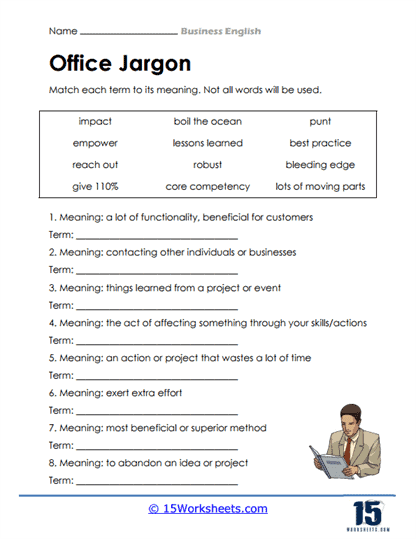
Unlike general English, Business English focuses on specific lexical sets (e.g., finance, marketing, human resources), formal register, conciseness, clarity, and the ability to handle complex professional interactions. This specialized knowledge is precisely what Business English worksheets are designed to deliver.
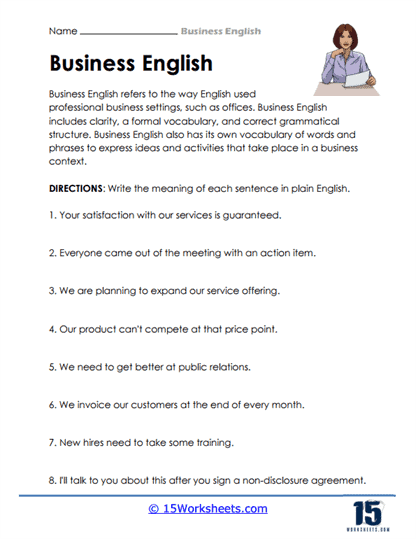
Why Business English Worksheets Are Essential Learning Tools
Business English worksheets offer a multitude of benefits that make them an indispensable component of any effective language learning program:
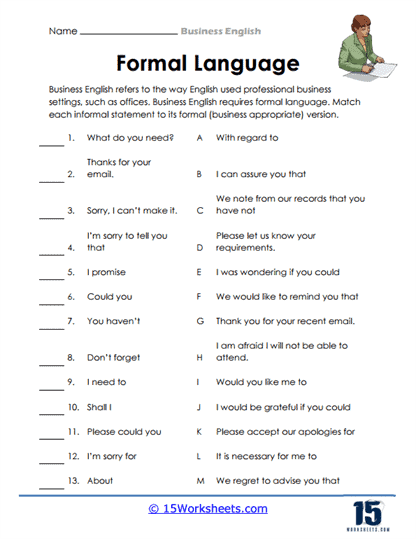
- Structured Practice: Worksheets break down complex topics into manageable segments, guiding learners through specific vocabulary, grammar points, or communication strategies related to business contexts.
- Targeted Skill Development: Whether the goal is to improve email writing, master presentation phrases, or understand financial reports, worksheets can be tailored to focus on particular skills or areas of weakness.
- Self-Paced Learning: Learners can work through worksheets at their own speed, reviewing difficult concepts as many times as needed, making them ideal for both independent study and classroom reinforcement.
- Reinforcement and Consolidation: By actively engaging with the material through exercises, learners reinforce newly acquired knowledge, helping to commit it to long-term memory.
- Confidence Building: Practicing in a low-stakes environment allows learners to experiment with new language without the pressure of a live business situation, gradually building their confidence.
- Cost-Effectiveness: Many high-quality Business English worksheets are available online for free or as part of affordable workbooks, making them an accessible learning resource.
- Authenticity: Good worksheets often incorporate authentic business scenarios, dialogues, and documents, preparing learners for real-world interactions.


Diverse Types of Business English Worksheets
The versatility of Business English worksheets is evident in the wide array of types available, catering to different skills, topics, and proficiency levels:
By Skill Focus:
- Reading Comprehension Worksheets: These might feature excerpts from business reports, emails, articles, or marketing materials, followed by questions testing understanding of main ideas, specific details, inference, and vocabulary in context.
- Writing Practice Worksheets: Learners might be tasked with drafting formal emails, memos, meeting agendas, minutes, short reports, or proposals. Exercises could include sentence completion, rephrasing, or full composition tasks.
- Listening Comprehension Worksheets: Accompanied by audio recordings (e.g., snippets of conference calls, presentations, interviews, or negotiations), these worksheets test listening for gist, specific information, and understanding implied meanings.
- Speaking Prompt Worksheets: Designed to facilitate oral practice, these often include role-play scenarios (e.g., conducting an interview, making a sales pitch, resolving a conflict), discussion questions, or prompts for short presentations.
- Vocabulary and Grammar Worksheets: These focus on specific business idioms, phrasal verbs, collocations, or grammar structures commonly used in professional settings (e.g., passive voice for reports, conditional sentences for negotiations).
By Business Topic/Context:
- Meetings & Presentations: Worksheets covering useful phrases for opening/closing meetings, interrupting politely, agreeing/disagreeing, asking for clarification, or delivering a persuasive presentation.
- Negotiation & Persuasion: Exercises on bargaining language, making offers, concessions, counter-offers, and strategies for achieving win-win outcomes.
- Email & Correspondence: Focus on formal vs. informal tone, subject lines, opening/closing phrases, clarity, conciseness, and dealing with various types of business emails (inquiry, complaint, request).
- Finance & Economics: Terminology related to accounting, investments, stock markets, economic indicators, and understanding financial reports.
- Human Resources: Language for job interviews, performance reviews, onboarding, and discussing HR policies.
- Marketing & Sales: Vocabulary for product descriptions, advertising, market research, and making sales pitches.
- Cross-Cultural Communication: Scenarios and discussions addressing cultural nuances in business etiquette, communication styles, and negotiation strategies.
By Proficiency Level:
Worksheets are typically categorized for Beginner, Intermediate, and Advanced learners, ensuring the content and complexity are appropriate for the user’s current English proficiency.
Key Elements of Effective Business English Worksheets
Not all worksheets are created equal. To maximize their learning potential, effective Business English worksheets should incorporate several key elements:
- Authenticity: The language, scenarios, and tasks should closely mirror real-world business situations. This might involve using actual company reports (adapted for learning), realistic email exchanges, or transcripts of business meetings.
- Clear Learning Objectives: Each worksheet should clearly state what skills or knowledge the learner is expected to gain by completing it. This helps learners focus and understand the purpose of the exercise.
- Variety of Exercise Types: A good worksheet moves beyond simple fill-in-the-blanks. It incorporates matching, true/false, multiple choice, open-ended questions, rephrasing, sentence completion, and even creative tasks like drafting an email or role-playing a scenario.
- Relevance and Practicality: The topics and language presented must be directly applicable to the needs of business professionals. Learners should be able to see how the skills practiced will benefit them in their careers.
- Answer Keys and Model Answers: For self-study, a comprehensive answer key is crucial for immediate feedback and self-correction. For writing tasks, model answers can provide valuable examples of structure and appropriate language.
- Cultural Awareness Notes: Especially important in Business English, good worksheets might include tips on cultural differences in communication styles, negotiation tactics, or social etiquette.
- Engaging Content: While business topics can be serious, the presentation should be engaging and motivating to keep learners interested.
Maximizing the Impact of Business English Worksheets
Simply completing a worksheet isn’t enough; effective engagement is key to maximizing its learning impact:
- Active Engagement: Don’t just skim. Read instructions carefully, think about your answers, and challenge yourself.
- Review and Reflect: After completing a worksheet and checking answers, review your mistakes. Understand why an answer was wrong. What specific rule or vocabulary item did you miss?
- Practice Out Loud: For speaking and even writing exercises, read your responses aloud. This helps with pronunciation, intonation, and identifying awkward phrasing.
- Connect to Real Life: Try to apply the learned vocabulary or phrases in your actual work environment, if possible, or imagine how you would use them.
- Supplement with Other Resources: Worksheets are best used as part of a broader learning strategy that includes reading business news, listening to business podcasts, watching industry-related videos, and engaging in real conversations.
- Seek Feedback (if possible): If you have access to a teacher or a proficient English-speaking colleague, ask them to review your written work or listen to your speaking practice.
Sourcing Quality Business English Worksheets
The internet is a treasure trove of resources for Business English worksheets. Here are some common places to find them:
- Dedicated ESL/EFL Websites: Many reputable language teaching websites offer free printable worksheets covering a wide range of Business English topics. Examples include ESL-Lounge, BusinessEnglishPod, and various university ESL program sites.
- Educational Publishers: Major publishers of English language teaching materials (e.g., Cambridge University Press, Oxford University Press, Pearson) often provide supplementary worksheets for their Business English coursebooks, some of which are freely accessible.
- Online Language Learning Platforms: Websites like Lingoda, Engoo, or even Coursera/edX might offer courses with downloadable worksheet components.
- Teacher Resource Sites: Platforms like Teachers Pay Teachers (often paid, but high quality) or British Council LearnEnglish for Business have extensive collections.
- Self-Creation: For highly specific needs, professionals or teachers can create their own worksheets by adapting authentic materials like company reports, emails, or news articles.
Beyond the Worksheet: Complementary Learning Strategies
While Business English worksheets are incredibly effective, they are most powerful when integrated into a holistic learning approach. To truly excel, learners should also:
- Immerse Themselves: Read business journals, listen to financial news, watch business documentaries, and follow industry leaders on social media – all in English.
- Engage in Real-World Practice: Seek opportunities to use English in actual business contexts, whether it’s participating in international conference calls, networking with English-speaking professionals, or presenting in English.
- Seek Professional Instruction: Consider enrolling in a Business English course with a qualified instructor who can provide personalized feedback, clarify complex concepts, and facilitate interactive practice.
- Join Conversation Groups: Practice speaking with peers who share similar professional interests, focusing on business-related topics.
Conclusion
In the competitive global landscape, proficiency in Business English is a critical asset for both individuals and organizations. Business English worksheets serve as a cornerstone for developing this essential skill set, offering structured, targeted, and flexible practice that reinforces learning and builds confidence. From mastering meeting etiquette to perfecting presentation delivery, these versatile tools provide the focused exercises necessary to bridge the gap between general English fluency and specialized business communication competence.
By strategically incorporating a variety of Business English worksheets into a comprehensive learning plan, alongside real-world application and continuous exposure, professionals can effectively navigate the complexities of the international marketplace, communicate with clarity and impact, and unlock new avenues for success in their global careers. They are not just exercises; they are stepping stones to becoming a truly effective global communicator.
